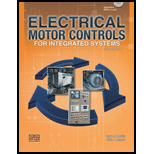
Electrical Motor Controls for Integrated Systems
5th Edition
ISBN: 9780826912268
Author: Gary Rockis;Glen A. Mazur
Publisher: American Technical Publishers
expand_more
expand_more
format_list_bulleted
Concept explainers
Question
Chapter 1.3, Problem 5CP
To determine
Whether the current and the voltage are in in-phase or out of phase, when the coil is inductive coil in AC circuit.
Expert Solution & Answer
Want to see the full answer?
Check out a sample textbook solution
Students have asked these similar questions
please explain and draw the graphs clearly, I am most confused with the graphs thanks
please show step by step and explain clearly
Please solve this question step by step handwritten solution and do not use ai or chat gpt please thank you
Chapter 1 Solutions
Electrical Motor Controls for Integrated Systems
Ch. 1.1 - Prob. 1CPCh. 1.1 - Prob. 2CPCh. 1.1 - Prob. 3CPCh. 1.1 - Prob. 4CPCh. 1.1 - Prob. 5CPCh. 1.1 - Prob. 6CPCh. 1.1 - Prob. 7CPCh. 1.1 - Prob. 8CPCh. 1.1 - Prob. 9CPCh. 1.1 - Prob. 10CP
Ch. 1.1 - Prob. 11CPCh. 1.1 - Prob. 12CPCh. 1.1 - Prob. 13CPCh. 1.1 - Prob. 14CPCh. 1.1 - Prob. 15CPCh. 1.2 - Prob. 1CPCh. 1.2 - Prob. 2CPCh. 1.2 - Prob. 3CPCh. 1.2 - Prob. 4CPCh. 1.2 - Prob. 5CPCh. 1.2 - Prob. 6CPCh. 1.3 - Prob. 1CPCh. 1.3 - Prob. 2CPCh. 1.3 - Prob. 3CPCh. 1.3 - Prob. 4CPCh. 1.3 - Prob. 5CPCh. 1.4 - Prob. 1CPCh. 1.4 - Prob. 2CPCh. 1.4 - Prob. 3CPCh. 1.4 - Prob. 4CPCh. 1.4 - Prob. 5CPCh. 1.4 - Prob. 6CP
Knowledge Booster
Learn more about
Need a deep-dive on the concept behind this application? Look no further. Learn more about this topic, electrical-engineering and related others by exploring similar questions and additional content below.Similar questions
- Find the mathematical expression in fourier series for this output below shown in the image. This must have the terms ao, ak and bkarrow_forwardPlease solve this question step by step handwritten solution and do not use ai or chat gpt please thank youarrow_forwardPlease solve this question step by step hand written solution and do not use ai or chat gpt thank youarrow_forward
- Please solve this question handwritten, step by step showing details and no ai or chat gpt solution please thank youarrow_forwardPlease explain each quations, I'll give positive feedback. For the graphs, please draw what it looks likearrow_forwardplease explain all steps and draw any drawings, don't just explain what they look like please. thank youarrow_forward
- please explain and show all steps, thank you.arrow_forwardA rectangular waveguide with dimensions a = 2.5 cm, b = 1 cm is to operate at 15 GHz. σ = 0, E4, μ= 1 3- Calculate phase constant for TE10 mode. 4- Calculate the phase velocity and wave impedance for the same mode.arrow_forwardFind v(t) for t> 0 in the circuit of Fig. below. Assume the switch has been open for a long time and is closed at t = 0. Calculate v (t) at t = 0.5. 10 V 202 www +21 t=0 60 ww 13 F بلا SVarrow_forward
- Q: A rectangular waveguide with dimensions a = 2.5 cm, b = 1 cm is to operate at 15 GHz. σ = 0, E4, μ = 1 1- At which frequencies this type of TL (transmission line) operate ? 2- Why this this type is used in such frequencies? 3- Calculate phase constant for TE10 mode. 4- Calculate the phase velocity and wave impedance for the same mode.arrow_forwardK Q1/ For the system G(s)= (s+2)(s+4)(s+5) H(s)=1 a. Draw the Bode log-magnitude and phase plots. b. Find the range of K for stability from your Bode plots. c. Evaluate gain margin, phase margin, zero dB frequency, and 180° frequency from your Bode plots for K = 200arrow_forwardQ3/A unity-feedback system with the forward transfer function S(S+7) is operating with a closed-loop step response that has 15% overshoot. Do the following: a. Evaluate the settling time. b. Design a PD compensator to decrease the settling time by three times.arrow_forward
arrow_back_ios
SEE MORE QUESTIONS
arrow_forward_ios
Recommended textbooks for you
 Introductory Circuit Analysis (13th Edition)Electrical EngineeringISBN:9780133923605Author:Robert L. BoylestadPublisher:PEARSON
Introductory Circuit Analysis (13th Edition)Electrical EngineeringISBN:9780133923605Author:Robert L. BoylestadPublisher:PEARSON Delmar's Standard Textbook Of ElectricityElectrical EngineeringISBN:9781337900348Author:Stephen L. HermanPublisher:Cengage Learning
Delmar's Standard Textbook Of ElectricityElectrical EngineeringISBN:9781337900348Author:Stephen L. HermanPublisher:Cengage Learning Programmable Logic ControllersElectrical EngineeringISBN:9780073373843Author:Frank D. PetruzellaPublisher:McGraw-Hill Education
Programmable Logic ControllersElectrical EngineeringISBN:9780073373843Author:Frank D. PetruzellaPublisher:McGraw-Hill Education Fundamentals of Electric CircuitsElectrical EngineeringISBN:9780078028229Author:Charles K Alexander, Matthew SadikuPublisher:McGraw-Hill Education
Fundamentals of Electric CircuitsElectrical EngineeringISBN:9780078028229Author:Charles K Alexander, Matthew SadikuPublisher:McGraw-Hill Education Electric Circuits. (11th Edition)Electrical EngineeringISBN:9780134746968Author:James W. Nilsson, Susan RiedelPublisher:PEARSON
Electric Circuits. (11th Edition)Electrical EngineeringISBN:9780134746968Author:James W. Nilsson, Susan RiedelPublisher:PEARSON Engineering ElectromagneticsElectrical EngineeringISBN:9780078028151Author:Hayt, William H. (william Hart), Jr, BUCK, John A.Publisher:Mcgraw-hill Education,
Engineering ElectromagneticsElectrical EngineeringISBN:9780078028151Author:Hayt, William H. (william Hart), Jr, BUCK, John A.Publisher:Mcgraw-hill Education,

Introductory Circuit Analysis (13th Edition)
Electrical Engineering
ISBN:9780133923605
Author:Robert L. Boylestad
Publisher:PEARSON

Delmar's Standard Textbook Of Electricity
Electrical Engineering
ISBN:9781337900348
Author:Stephen L. Herman
Publisher:Cengage Learning

Programmable Logic Controllers
Electrical Engineering
ISBN:9780073373843
Author:Frank D. Petruzella
Publisher:McGraw-Hill Education

Fundamentals of Electric Circuits
Electrical Engineering
ISBN:9780078028229
Author:Charles K Alexander, Matthew Sadiku
Publisher:McGraw-Hill Education

Electric Circuits. (11th Edition)
Electrical Engineering
ISBN:9780134746968
Author:James W. Nilsson, Susan Riedel
Publisher:PEARSON

Engineering Electromagnetics
Electrical Engineering
ISBN:9780078028151
Author:Hayt, William H. (william Hart), Jr, BUCK, John A.
Publisher:Mcgraw-hill Education,